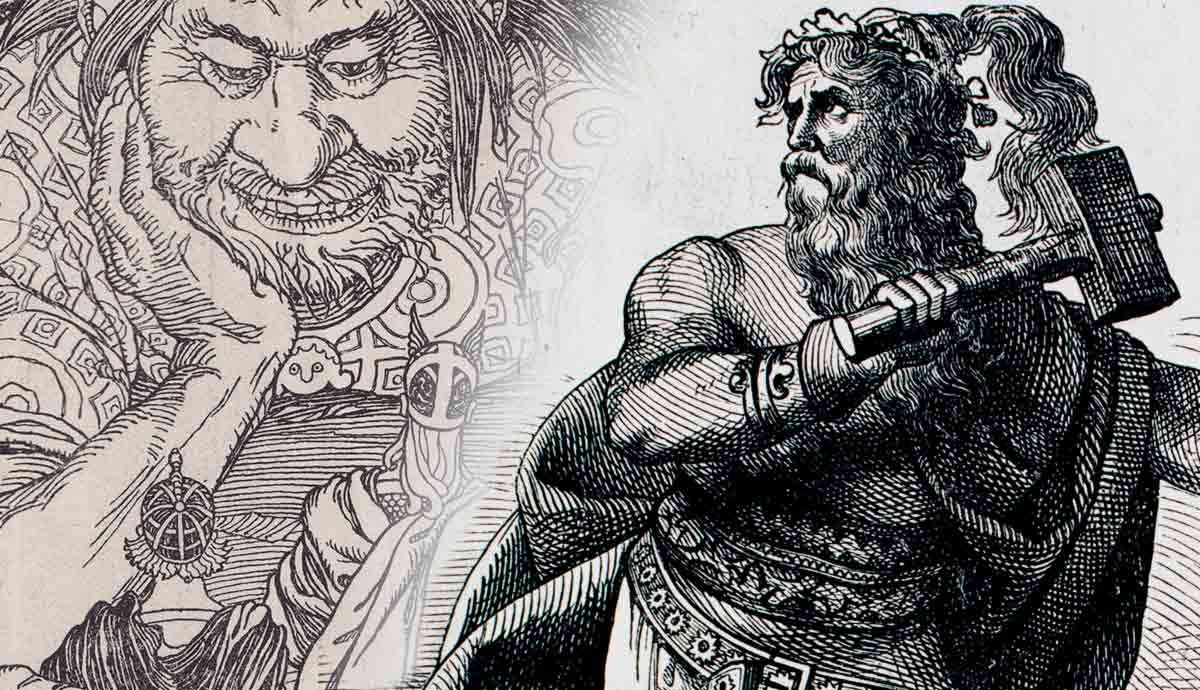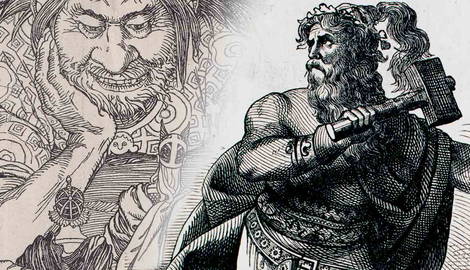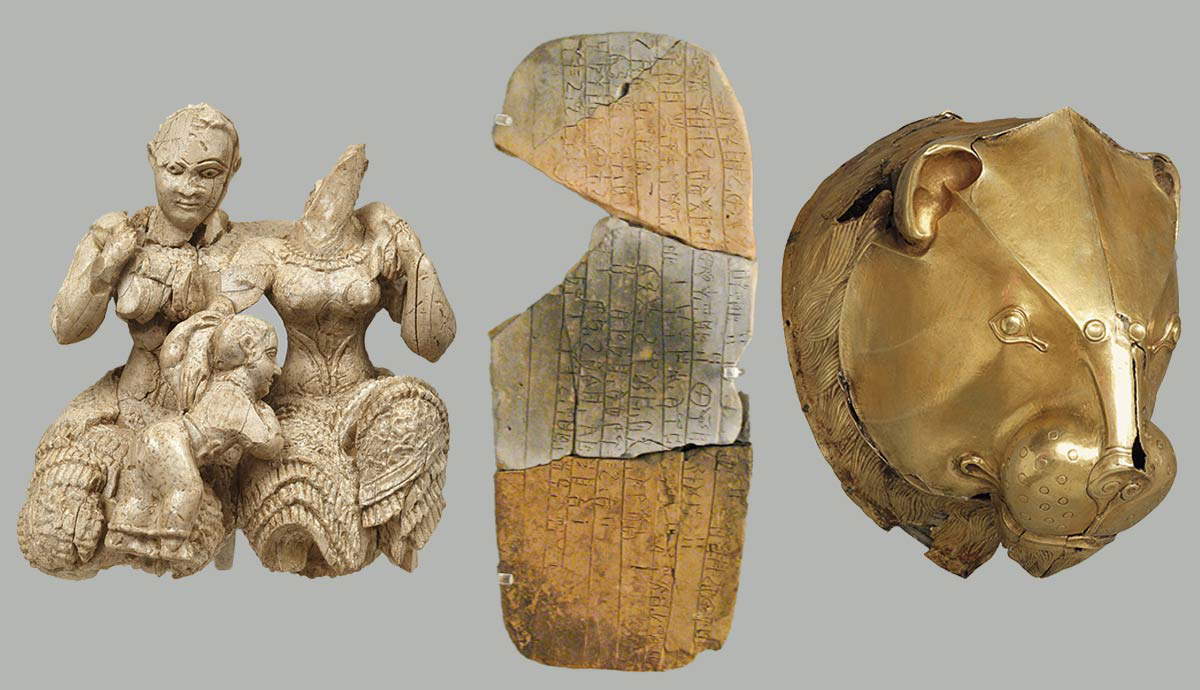
The Prose Edda preserves a strange story that sees Thor, Loki, and two servants traveling to Jotunheim. But when they get there, nothing is as it seems. They encounter a world of illusion. Overall, it feels a bit like the Norse version of Alice’s Adventures in Wonderland. Many of the details of the story also seem inconsistent with what we know from other Norse myths. This has led many to question whether it really belongs to Norse belief, or whether it is a fairytale invented by the Christian recorder of the story. Let’s deep dive into this fantastical story, the evidence for its authenticity, and what it reveals about Norse mythology.
Episode One: The Journey Through Midgard

The story begins with Thor and Loki deciding to go on an adventure to Jotunheim, the land of the giants. Thor, the god of thunder, considered the strongest of the Norse gods, and the trickster giant Loki, who is allowed to live among the gods, often go on adventures together in various myths. They call Jotunheim “Utgard,” which means “beyond the fence.” The Norse called the realms protected by the gods, such as Asgard, the divine realm, and Midgard, the realm of men, “gards,” because they are “within the fence” created by divine law and protection. Other realms, such as Jotunheim and Helheim, are called “heims,” which are just lands. With the name Utgard, Jotunheim is specifically being called a realm beyond the fence, implying that the same rules do not apply there.
From Asgard they must travel through Midgard to reach Jotunheim. They leave early in the morning and are still in Midgard as night falls, so they seek accommodation with a farmer. Despite being very poor and unable to offer a proper meal, the family must accept the gods under the rules of hospitality.
Seeing their dire situation, Thor kills the two goats that pull his chariot and offer their meat up for the meal. He also spreads their skins on the grounds and warns the farmer and his family not to damage the bones but throw them on the skins. While the family fears and respects the god, the son of the family, Thjalfi, has not eaten so well in a long time and can’t resist sucking some of the marrow out of one of the leg bones.

The next morning, Thor uses his hammer Mjolnir to bless the skins and bones and bring his goats back to life. This imitates what happens to the beast Saehrimnir in Valhalla, the afterlife for warriors, who is cooked every day and brought back to life each night. When he reanimates the goats, Thor immediately sees that one is lame. This throws him into a rage, and he considers killing the farmer and his family. But the farmer offers Thor his son, Thjalfi, and daughter, Roskva, as his servants.
Thor accepts, and the story says that they have attended him ever since. It is unclear whether their service to the gods obtains them some kind of immortality. Roskva is barely mentioned for the rest of the story, as was common for female characters in most Norse myths.
Episode Two: Meeting Skrymir

The party of four leave the goats behind with the farmer, continuing their journey. When they come to the sea that separates Midgard and Jotunheim, they find a boat to travel across it. Arriving in Jotunheim, they must travel through dense forest. Interestingly, Thjalfi is described as the fastest runner and being sent ahead as a scout. It is hard to imagine that he could move faster than the gods.
They find very little shelter on their journey, but when night falls, they do come across a strange hall, with a doorway as wide as the building is tall. It is so dark inside that they can’t see much, so they stay near the entrance. But at midnight, the group is awakened by loud rumbling sounds and what feels like an earthquake. In fear, they retreat further into the building. They discover five rooms, one large room leading off to the side and four smaller rooms in front of them. They take refuge in the side room, with Thor standing guard at the entrance.

At dawn, they leave the building and find a giant sleeping on the ground nearby. He is so enormous that they did not see him in the night because he looked like a hill. This is a surprise to the group as the giants are not described elsewhere in Norse mythology as being of enormous stature. Remember, Loki himself is a giant and the same size as Thor.
Sensing the commotion, the giant awakes and introduces himself to the group as Skrymir, informing them that he is considered a dwarf among his people. He then picks up the building they had been sleeping in, which turned out to be his glove. They had been hiding in the thumb. The five agree to travel together for a while, and Skrymir offers to carry their packs, placing them in his own giant pack.

The group walk all day until they reach an oak grove. When they settle down for the evening, Skrymir decides to sleep but tells them to take what they need from his pack. But when Thor tries to open the pack, he finds that he, the strongest of the gods, cannot open the ties. Growing angry, Thor, who is impulsive and quick to anger in most Norse myths, strikes the giant in the head with his hammer Mjolnir. To his surprise, rather than killing the giant, he simply awakes and asks if a feather has fallen on his head. This surprises and angers Thor, whose hammer can level mountains, and up until now, kill any foe. The group sleeps, hungry and afraid.
At midnight, Skrymir begins to snore again, uprooting trees and awakening the group. Thor decides to try and kill him again, this time with a harder blow. But the result is the same, with the giant awaking and asking if an acorn has fallen on his head. At dawn, the group awakens before the giant, and yet again Thor tries to kill him. Thor hits him so hard that he is sure the hammer has sunk into his brain. But instead, the giant awakens and asks if there are birds overhead whose droppings have landed on his head.
As the day begins, Skrymir tells the group that it is time for them to part ways. There is a stronghold to the east, but he intends to continue traveling north. Skyrmir warns the group that they would be better off going home than to the stronghold, but if they do go, not to be prideful or brag, as the giants there would not accept that from such small creatures. Of course, this angers the mighty Thor.
Episode Three: Challenges in the Hall of Utgard-Loki

When the group arrives at the stronghold, they find the gates unattended, but they are so enormous that the group can just slip through. They discover a hall full of enormous giants, even larger than Skyrmir. They make their way to the king, called Utgard-Loki. While the group is respectful, the king responds with a sneer, saying that he finds it hard to believe that the little man before him is the mighty Thor. But he wonders if the group is stronger than they look. He asks them what they excel at, as only those who are masters of something are welcome at his table. Living beyond the gard, he is not compelled by the laws of hospitality.
Loki volunteers that he can eat faster than anyone else, so the giant king puts him to the test. He has his people bring out an enormous wooden slab covered in meat and summons the giant Logi to compete. Starting at either end of the slab, Loki and Logi see who can eat the fastest. While both reach the middle at the same time, it is soon discovered that while Loki only ate the meat, Logi also ate the bones and the slab itself!
Thjalfi then volunteers that he is a fast runner, so he is set to race against Hugi. In the end, they raced three times, with Hugi beating Thjalfi by a wider margin each time. In the final race, Hugi finished before Thjalfi even reached the halfway point.

Now the giant king turns his attention to Thor, who initially says that he is an excellent drinker. He gives Thor a large horn, saying that a good drinker can drain it in one gulp, a moderate drinker in two, and even the poorest of the giant drinkers need only three. Thor takes three mighty gulps, but barely drains the horn at all, which he returns to the giant in defeat.
Utgard-Loki decides to give him another chance, saying that many of the smaller giants lift his cat as a show of strength. But when Thor makes the attempt, he can only get one paw off the ground. As the giants laugh, the angry Thor says that he will fight anyone. Utgard-Loki said that it would be an embarrassment for any of his giants to fight Thor, so he calls his old nursemaid Elli as an appropriate opponent. Try as he might, Thor could not destabilize the crone, but she forces him to one knee, winning the wrestling bout.
In response, Utgard-Loki says that there is no point in further challenges, but still offers the group food, drink, and a place to sleep.
Episode Four: The Truth Revealed

The next morning, thoroughly embarrassed, the group decides to leave before the giants awake. But as they make their way through the hall, they are intercepted by Utgard-Loki, who escorts them out. The giant king asks Thor what he thought and whether he had ever met anyone as powerful. Thor admits that he had not and that he had been put to shame.
It was now that Utgard-Loki revealed to the group that it was all a deception. It was he himself who had masqueraded as Skrymir to find them on the road. He has tied his pack with wires to ensure that Thor would not be able to open it. He had placed a mountain between his head and Thor’s hammer to protect himself. He pointed to three valleys in the surrounding countryside, saying that Thor had created them with his blows.
In the hall, Loki had competed with Logi, whose name means wildfire, which consumes all before it. Thjalfi had raced against Hugi, whom no one could outrun. The horn Thor had drunk from had contained the sea, and he had drunk so much that the group would notice that water level was lower on their return journey. The cat was the enormous serpent Jormungandr that lives in the Midgard Sea. Thor had lifted him so high that he had almost caused tidal waves. Finally, the nursemaid Elli was of old age, which no one can defeat.

Utgard-Loki told Thor that the god was much stronger than he had expected, and that if he had known how strong Thor was, he would never have let him enter his hall. He also told the god never to return, or he would use the same tricks against him. This deception angered Thor, who made a mighty swing for the giant with Mjolnir, but the hammer swung through air. The giant and the stronghold disappeared before their eyes, leaving only a pleasant landscape before them. This is an interesting detail, as Jotunheim is usually described as a desolate and dangerous terrain.
The group returned to Midgard, retrieved Thor’s goats and chariot, and the four traveled to Asgard. But Thor resolved to return to Jotunheim, and also to seek out Jormungandr, which may explain why he was so determined to catch the serpent on his famous fishing trip with Hymir, a normal sized giant.
The Authenticity of the Story

This story of Thor’s adventures in Jotunheim is preserved in the Prose Edda, a text on Norse poetry and mythology composed by the Icelandic Christian author Snorri Sturluson in the 13th century. While Sturluson is our source for many surviving stories from Norse mythology, and is known to have drawn from older sources, there is evidence that he sometimes invented things to fill gaps and that his interpretation and presentation were impacted by his Christian beliefs. Scholars always try to look for confirmation elsewhere when Sturluson is our only source. But because the pagan Vikings did not write extended prose about themselves, this is often challenging.
The story of the journey is part of a bigger story called the Gylfaginning. This sees the Swedish King Gylfi, traveling under the name Gangleri, arrive in Asgard, the realm of the gods. In a move that parallels the story, the gods create an illusion for Gylfi, so he does not see the true nature of their realm. Instead, when he arrives, he sees three enthroned figures called “High,” “Just as High,” and “Third.” Scholars believe that these are all illusions created by the god Odin, and therefore speak with Odin’s voice.

As Gylfi asks them questions about the past, present, and future, they share stories with him about the Norse gods. These stories include Thor’s journey, recounted by Third. When they have had enough of Gylfi, the illusion disappears, again paralleling Utgard-Loki’s disappearance in the story, leaving Gylfi perplexed.
While details of the story of the journey are not recorded anywhere else, there are passing references to it in older surviving texts, suggesting that the story was not invented by Sturluson, even if his retelling is not entirely faithful.
The Lokasenna tells the story of Loki crashing a banquet of the gods and insulting everyone present in turn. When it comes to Thor, Loki reminds him how he once cowered and hid in the thumb of a glove and forgot his greatness. This clearly refers to the encounter with Skrymir, and the fact that Thor was humbled on this particular journey to Jotunheim. The Lokasenna is found in the Poetic Edda, a 13th century collection of older Norse poems. The original Lokasenna is thought to date to the 10th century, so well before Snorri Sturluson.

There is also a reference to an Utgarthilocus in the Gesta Danorum, a history of the Danes written by Saxo Grammaticus in the 12th century. He describes a hero called Thorkel traveling to Jotunheim where he comes upon the wretched giant in a filthy and murky chamber who has fetters on his feet, long and disheveled hair and smells appallingly bad. His hairs are as tough as wooden spears, and Thorkel plucks one out as evidence of the encounter. When he returns home, many people die from the smell of the hair.
But it is speculated that the Utgarthilocus that Thorkel encounters must be Loki, who was imprisoned by the gods for his role in the death of the god Balder. But how can Utgard-Loki and Loki be one and the same when they both appear in the story of Thor’s journey in different roles?
This is one of the great mysteries of the story that has received much attention. Some suggest that the Utgard-Loki encountered in the story is Loki, and that the Loki who accompanies Thor is taking the place of another god because Loki and Thor were so often depicted traveling together. This seems questionable since we know that Loki lived in Asgard among the gods.
A more plausible suggestion is that Utgard-Loki was not the original name of the giant, he was just a giant king of Utgard. Loki may have been used as a kenning for giant, resulting in Utgard-giant becoming Utgard-Loki. Kennings are poetic descriptions for proper nouns, which in Old Norse poetry drew on Norse mythology. This is actually why Snorri Sturluson wrote his Prose Edda, as a poetry guide, since poets had to be familiar with the mythology.

Kennings could be quite elaborate. While Thor was known by simple kennings such as the “son of the All-father (Odin),” “father of Thrud (his daughter),” and “companion of Sif (his wife),” he was also called the “deep-minded, mighty, reliable, victory-blessed father of Magni (his son),” the “life-destroyer of the evil causing troop of Beli (troop of Beli being a kenning for giants),” and the “action-liberal rage-familiar, misfortune destroyer of Loki.”
Kennings for Loki included the “friend of the raven god (Odin),” the “amazingly cunning son of Farbauti (Loki’s father),” and the “by no means trustworthy mind-tester of the Gautr of host-thunder (Thor).” It is not a stretch to see Utgard-Loki initially applied as a kenning referring to the trickster giant who lived in Utgard. It may have become shorthand for this particular giant king, who was not the Loki who lived with the gods and would go on to cause Ragnarök.
However, as is often the case with ancient stories that have been transmitted over the centuries, we will probably never be able to unravel all its secrets.










